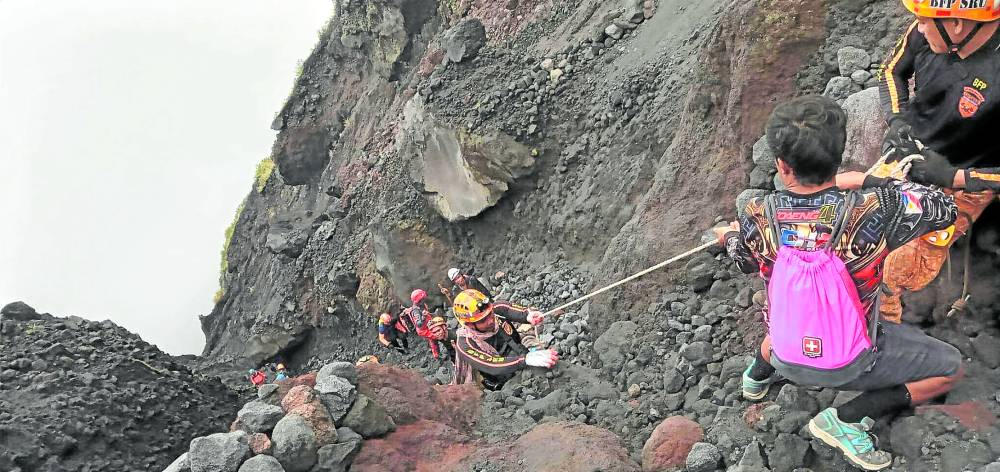
TEAMEFFORT Members of the team tasked to find the Cessna plane that crashed on Mt. Mayon on Feb. 18 make their way toward the wreckage on a gully near the volcano’s summit crater on Thursday. The teamhad to brave steep, slippery and rocky slopes to retrieve the bodies of the four people aboard the plane. (PHOTO COURTESY OF CESSNA 340A INCIDENT COMMAND POST)
LEGAZPI CITY—The four persons on board a Cessna plane that crashed on Mayon Volcano were confirmed dead on Thursday, but the team sent to search for the wreckage reported that it might take a while to retrieve the bodies due to the steep and dangerous terrain, authorities said.
At a press briefing on Thursday, Camalig Mayor Carlos Irwin Baldo Jr., the incident commander, said they could still not determine the time the bodies would be brought down from the crash site, considering the difficult terrain.
“Even if they (retrieval team) already found [the bodies], it would still be difficult for them to carry them down because of the dangerous terrain. They had a hard time trekking upward, what more on the retrieval,” Baldo said.
The Cessna RPC340 went missing on Feb. 18, carrying its pilot, Capt. Rufino James Crisostomo Jr.; his mechanic, Joel Martin; and their two Australian passengers, Simon Chipperfield and Karthi Santhanam.
Crisostomo and Martin were long-time employees of the Energy Development Corp. (EDC), the largest geothermal energy producer in the Philippines. The Australians were EDC’s technical consultants.
The Metro Manila-bound plane disappeared just minutes after it took off from the Bicol International Airport (BIA) in Daraga, Albay, at 6:43 a.m. of Feb.18. The aircraft was last spotted at 6:48 a.m. passing over the plant of Goodfound Cement Corp. in Camalig town, at an altitude of 790 meters, reports said.
“Our heartfelt sympathies go to their families and friends during this difficult time,” Richard Tantoco, EDC president and chief operating officer, said in a statement on Thursday.
In an interview, Frances Ariola, head of corporate communications at EDC, said Crisostomo had been working as the company’s pilot for 12 years, and attended international training with his mechanic during the pandemic.
Eduardo Jimenez, corporate relations head of the EDC Bacon-Manito geothermal facility, assured that they would continue supporting the local government and the families of the victims. “We helped even with the procedural and logistical requirements,” Jimenez said.
The aircraft’s wreckage was located some 350 meters (1,148 feet) from the volcano’s summit crater on Sunday after an aerial search, but bad weather made it difficult for the ground team to reach the crash site.
The 28-member team, composed of local mountaineers, government rescuers and local guides, started to climb on Tuesday to reach the crash site, about more than 1,800 meters (6,000 feet) from the base of the volcano.
Baldo said 179 people so far were involved in the operation to carry the bodies down the steep slopes.
Poor visibility
As of Thursday morning, Baldo said the team was still planning which trail to take, as they were also considering the difficulty of carrying the bodies as they negotiated slippery rocks and unstable ground.
He also said the team could not move freely because of poor visibility in the area.
“The volcano has many gullies, and they are still studying the easiest way down. It depends on them,” he added.
Photos from the crash site showed that the light aircraft hit the steepest and most unstable area on the volcano.
In this area are black sand and rocks emitted by Mayon during its previous eruptions and one wrong step can send anyone sliding several meters down, Baldo said.
He said the bodies were found near the wreckage and believed to have been blown out of the plane after a possible explosion. He, however, did not disclose the condition of the remains.
But at the same briefing, Cedric Daep, chief of the Albay Public Safety and Emergency Management Office, said the cold temperature at the summit of the volcano likely slowed down the bodies’ decomposition.
“The temperature helped preserve the body,” Daep said.
Col. Rommel Ronda of the Civil Aviation Authority of the Philippines aircraft accident investigation and inquiry board, said the aircraft had no black box as it did not meet the weight requirement for the installation of the device.
An investigation is ongoing to determine what caused the air accident.
“When we learned about the incident last Saturday, we already started gathering documents … but it is still ongoing. And now, we will still retrieve the bodies [of the victims], and [there is still] a long process to complete [the] investigation,” Ronda said.